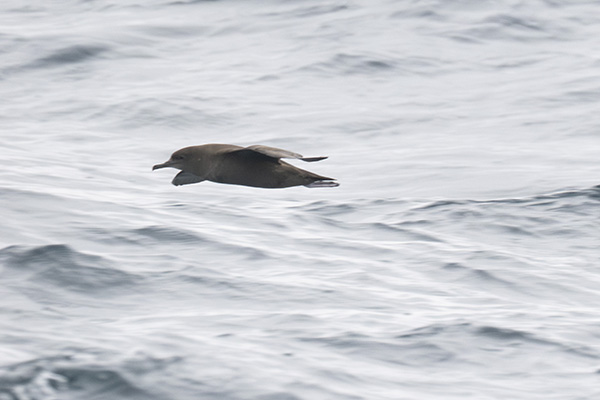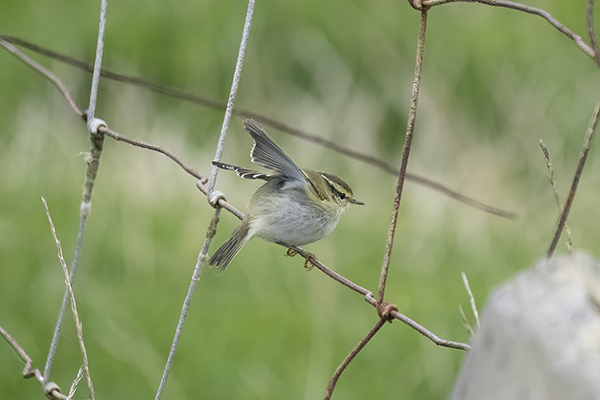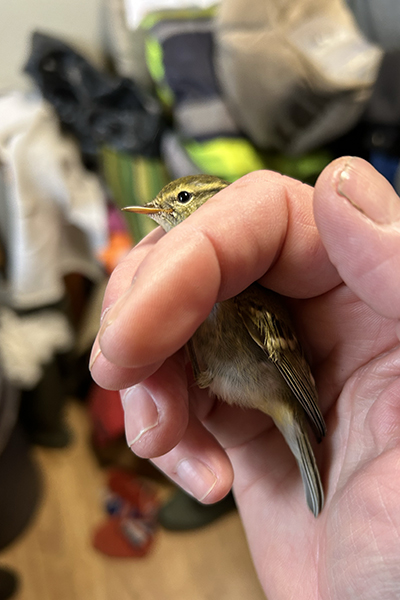After two days of typically dreich Fair Isle weather our penultimate day dawned breezy but thankfully clear. Determined to get our out and find something as well as the need to walk off Hollies superb meals we set off with our packed lunches and startd the routine of checking all available cover. It was obvious there'd been a movement of Yellow-browed Warblers overnight as they were literally in every garden and ditch we looked at. There were also some large dark looking 'rostrata' type Redpolls. So different i nsize and structure to our more familiar Lesser (formerly) Redpoll.
Heading north and reaching the plantation there were two unringed birds there so we messaged the Obs staff and Luke arrived with the rings and colour rings. Staying to help I left Jase to walk on and arranged to meet him at the Obs construction site.
We caught the two Yellow-browed Warblers and whilst we were ringing them three more literally dropped out the sky into the plantation and we walked them into the plantation heligoland. Jason had found more at the gully and in the Obs garden. Its incredible to think of how far these small Siberian 'sprites' have travelled to get here. With so many Yelllow-browed Warblers arriving from the east the feeling was there was something else rare lurking in the ditches and along the dykes.
Birds were definitely moving and taking advantage of the fine weather. It was a regualr raptor fest with Deryk finding a Black Kite soaring over Burkle and eventually heading out to see and lost to site (it ended up being se nat North Ron bird Obs). Luke found a cream headed Marsh Harrier which we picked up as it flew north along the eastern cliffs and Sparrowhawk, Peregrine, Kestrel and Merlin were all seen within the space of an hour.
Heading back south from the Obs we found a few more Yellow-browed Warblers as well as Garden Warblers, Blackcaps and Willow Warblers. Stopping at Lower Leogh to check out the Siberia nStonechat and Common Rosefinch we ended up back at The Haa and Walli Burn. The Lapland Buntings that had been frequenting the area were along the burn and several Lesser Whitehroats showed well in the garden.
We were viewing from different sides and I couldn't see Jason but heard his shout of 'Golden Oriole'. Apparently it had been sat with his back to him on a stick and it ws only when he lifted his binoculars that he realised what it was. The bird flew past me and landed briefly on a washing line support before disappearing up the side of the house. Despite searching all the nearby areas we couldn't refind it but on returning to The Haa it exploded past me and did its disappearing act again only fot Deryk to message to say it had flown past Burkle. Although there have been a number of records (55) of Golden Oriole on Fair Isle this was only the 9th Autumn record.
Deciding to head north to Quoy and look for it there we drew a blank and sat on one of the benches strategically placed by Elizabeth & Nick at Schoolton to allow birders to sit and view their garden. Suddenly the Golden Oriole was flying towards us and perched up on some incongruous looking tropical vegetation before flying to the croft garden.
As we watched it Luke made an appearance, running up the hill in his shorts and wellies, followed by Dougie Barr. Pointing out where the bird was perched up they both saw it before it again flew off and ended up in the back garden before flying off again and landing on a wall outside the conservatory of Houll where, following a phonecall from Luke, Eileen managed to see it from her window. The bird then flew and landed on a post in the middle of a field where it sat long enough for a few others to catch up with it. A lifer for Luke and we were happy to return the favour for the help he'd given us during our stay.
 | |||
Waving to Jonny Fisk. Thanks Jonny.
This was to be the last bird of pur trip. Meeting Dennis Morrison at Grutness he kindly gave us and our bags a lift to Sumburgh airport where we had several hours wait for our flight. An uneventful journey had me arriving home at 1 am tuesday morning and falling asleep already making plans to return to Fair Isle. Hopefully we'll see the dream team of Alex, Luke and Jonny there next year.. A great trip with the obvious avian highlights being Tennessee Warbler, Ortolan, Lapland & Little Buntings, Arctic Warbler, Yellow-browed Warblers, Golden Oriole, Pectoral Sandpiper, Wryneck and Barred Warbler! Above: Barred Warbler, Burkle |









































rtolan%20Bunting2.jpg)

































































